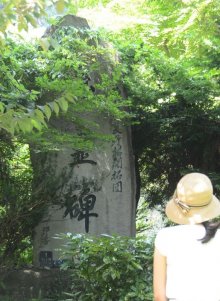
A monument commemorating a settlers group is seen at the Zenkoji temple charnel house in the city of Nagano.
NAGANO -- Many of over 50 memorials built in Nagano Prefecture to commemorate those who died in the wartime Japanese emigration to Manchuria have been neglected as their bereaved family members as well as those who have returned to Japan after World War II are aging. Concerned parties are demanding the national government and local bodies take over duties to manage these monuments since the emigration was promoted as a national policy.
Approximately 270,000 Japanese migrated to Manchuria between the 1930s and early 1940s, and over 70,000 of them died as a result of harsh living conditions after the war. Nagano Prefecture sent the highest number of residents, some 33,000, to northeastern China.
At a charnel house of Zenkoji temple in the city of Nagano, four memorials built by former settlers in Manchuria stand next to each other. One of them was set up in 1975 by returnees belonging to the No. 6 Nagano village settlers group. The group was made up of about 1,300 people, mainly those from southern Nagano Prefecture, who migrated to Dongan Province, which is now the province of Heilongjiang. More than 700 members of this group died in the harsh living environment as refugees after the war.
Hidden behind untrimmed trees, it is hard to read the inscriptions on the monument that tell the history of the Manchuria settlers. An employee at the charnel house office says a memorial ceremony has not been held before the monument for over a decade.
Another monument there is dedicated to a settlers group which consisted of over 250 boys aged between 14 and 15. Eleven members died after the war and the monument was built in 1967. More than 70 people used to participate in memorial ceremonies, but the number gradually dropped, and at a ceremony in October last year only five people showed up. Since the group was made up of members from different areas, including other prefectures, former members and bereaved families cannot rely on municipal governments to organize memorial ceremonies or take care of the monument. They cover the cost of management through donations or their own money.
A person who participated in last year's memorial ceremony said, "It's our duty as survivors to think of our fellow members before the monument."
According to Aki Misawa, director at Manmo Kaitaku Heiwa Kinen-kan (Manchurian settlement peace memorial museum) in the Nagano Prefecture village of Achi, the town of Nagiso is involved in the management and organizing of a monument and memorial ceremonies for Japanese settlers in Manchuria, but she says such a case is rare.
"Partly because many municipalities in Japan went through a series of mergers (until the first half of the 2000s), local governments have become less aware of the fact that they sent settlers to Manchuria. Those monuments need to be preserved to tell the history to future generations," Misawa commented.


